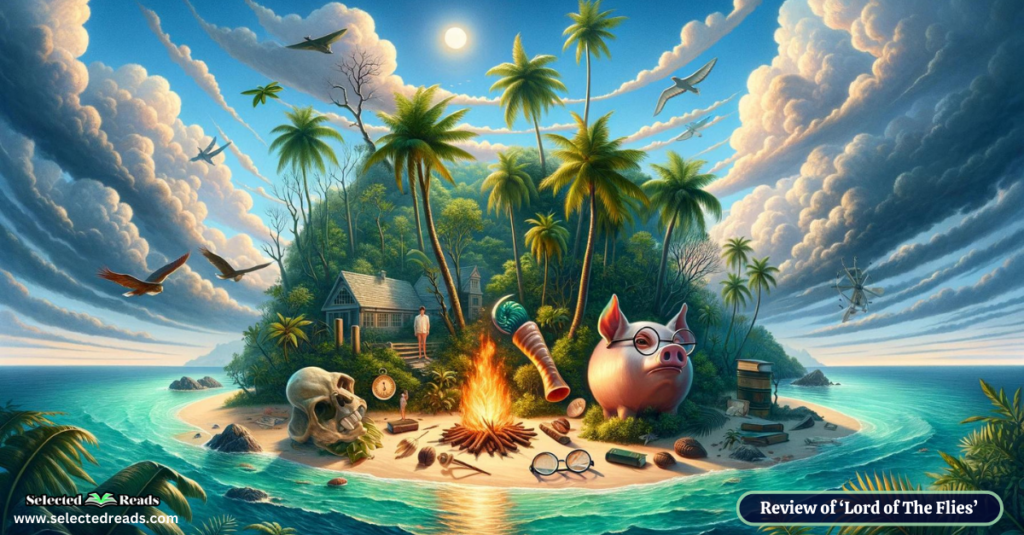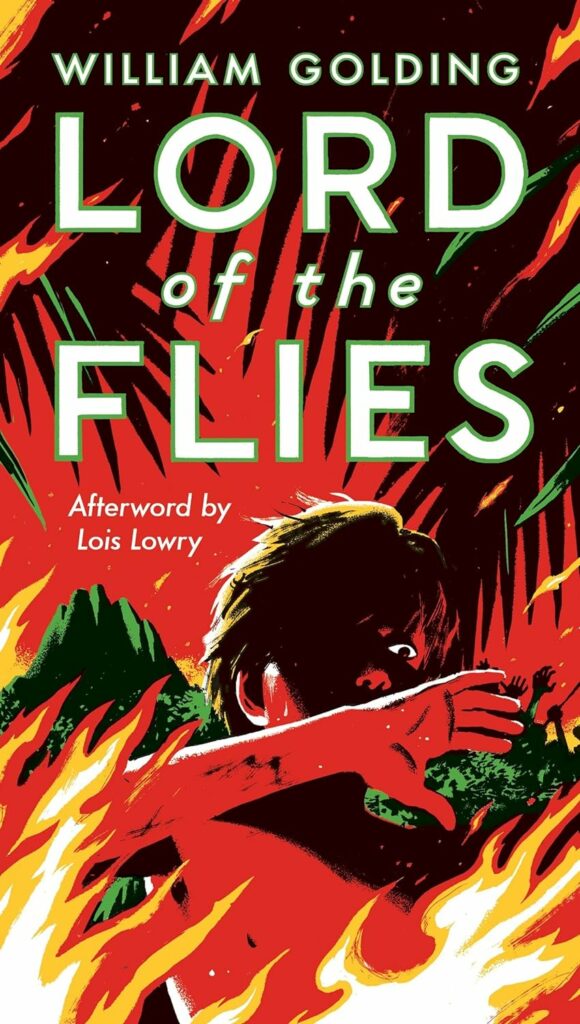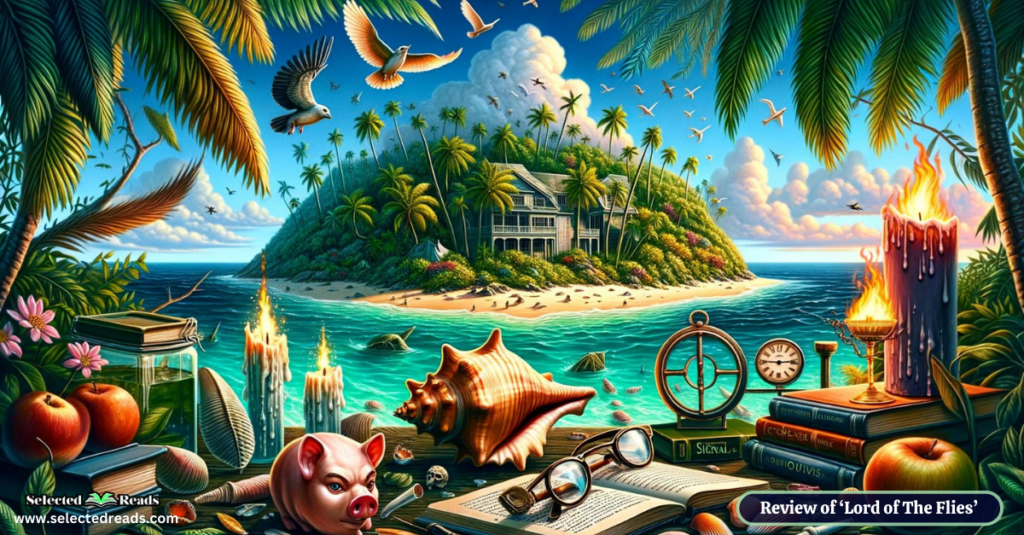In today’s post, we’re diving into the depths of William Golding’s classic novel, “Lord of the Flies.” This book, a staple in the literary world, offers a profound exploration of human nature, societal structures, and the thin line between civilization and savagery. Our journey through this iconic piece will be threefold.
First, we’ll delve into an extended summary of “Lord of the Flies.” The aim is to peel back the layers of the narrative, exploring the intricate dynamics at play among the characters and the underlying themes that make this novel a timeless piece of literature.
Next, we’ll introduce you to the characters who inhabit this story. Each character in “Lord of the Flies” is a vital piece of the puzzle, representing different aspects of society and human nature. Understanding these characters is key to grasping the novel’s full impact, as they bring to life the complex themes Golding intended to explore.
Finally, for those of you keen on delving deeper, perhaps in a book club or classroom setting, we’ll provide a set of thought-provoking discussion questions. These questions are designed to spark debate and introspection, allowing readers to engage with the novel on a deeper level.
Check out: Popular Lord of the Flies Quotes
Lord of the Flies Summary
“Lord of the Flies” begins with a group of British boys stranded on a deserted island after their plane is shot down during what seems to be a global conflict. The boys, ranging from six to twelve years old, are initially elated by the absence of adults and the prospect of absolute freedom. Ralph, one of the older boys, is quickly elected as the leader, with the intellectual Piggy as his adviser. Ralph’s primary objective is to maintain a signal fire to attract rescue, signifying the boys’ desire to return to civilization.
However, as days turn into weeks, the initial unity among the boys fractures. Jack, the leader of the choirboys and a natural antagonist to Ralph’s authority, becomes obsessed with hunting and asserts his dominance by forming a separate tribe focused on the primal act of hunting pigs, offering a sinister sacrifice to a perceived beast that terrorizes the island. This “beast” becomes a symbol of the boys’ inner savagery and fear, driving them further apart.
Photo: Amazon
The tension between Ralph’s group, which clings to the hope of rescue and the vestiges of civilized behavior, and Jack’s tribe, which descends into barbarism, escalates dramatically. Tragically, the intellectual and physically vulnerable Piggy is killed in a confrontation over a pair of glasses used to start the signal fire, a moment that signifies the near-complete breakdown of order and decency among the boys.
Simon, a solitary and sensitive boy, experiences a profound revelation about the nature of the “beast” the boys fear; he realizes that the true beast lies within each of them, a capacity for evil inherent in human nature. Before he can share this insight, he is brutally murdered by the boys in a frenzied ritual that blurs the line between civilization and savagery.
The conflict culminates in a hunt for Ralph, now the last representative of societal order and rationality. As Ralph flees for his life, he stumbles upon a naval officer on the beach, the outside world’s sudden intrusion into the boys’ isolated descent into primitive existence. The officer, perceiving the boys’ state as mere childish play gone wrong, fails to grasp the profound darkness and loss of innocence that the boys have experienced. The novel ends with the boys being rescued, but they are irrevocably changed by their ordeal, mourning the loss of their innocence amidst the recognition of the darkness within themselves and by extension, within all humanity.
Related: Suicide Notes Summary
Lord of the Flies Characters
In William Golding’s “Lord of the Flies,” the characters are primarily British schoolboys who find themselves stranded on an uninhabited island. Each character represents different aspects of society, human nature, and leadership styles. Here’s a rundown of the main characters:
- Ralph: Ralph is one of the oldest of the boys, and he quickly becomes the group’s leader due to his charisma and ability to organize. He represents order, civilization, and leadership. Ralph tries to maintain structure and hopes for rescue, emphasizing the need for a signal fire.
- Piggy: Piggy is Ralph’s loyal sidekick, distinguished by his physical shortcomings (he’s overweight and asthmatic) and his intellectual prowess. He wears glasses, which become a key tool for the boys (as they use them to start fires). Piggy represents the scientific and rational side of civilization.
- Jack Merridew: Jack is the novel’s primary antagonist. He starts as the leader of the choirboys and becomes the leader of the hunters. Jack represents savagery and the desire for power. He is charismatic and manipulative, eventually forming his own tribe that opposes Ralph’s leadership.
- Simon: Simon is a shy, sensitive boy. He’s depicted as a kind of Christ-figure in the novel, representing goodness and spirituality. Simon has a deep connection with nature and often goes off alone to a secluded spot on the island. His character delves into the inherent goodness of humanity.
- Roger: Roger is a quiet, brooding boy who displays a natural inclination towards cruelty. As the novel progresses, his sadistic nature becomes more apparent. He represents the darker side of human nature.
- Sam and Eric (Samneric): These twins are loyal followers of Ralph and are often treated as a single entity (hence the name “Samneric”). They represent the common folk or the followers in society, easily swayed and not strongly individualized.
- The Lord of the Flies: While not a character in the traditional sense, the Lord of the Flies is the name given to the sow’s head that Jack’s tribe impales on a stake as an offering to the “beast.” The Lord of the Flies becomes a symbol of the power of evil and a kind of satanic figure that evokes the beast within each human being.
Related: Better Than the Movies Summary
Lord of the Flies Book Club Questions
Lord of the Flies” is a novel that is rich in symbolism and thematic depth thus offering a great opportunity for deep analysis and debate. Here are some discussion questions that can help in unraveling the complex layers of the novel:
- Civilization vs. Savagery: How does Golding portray the struggle between the civilizing instinct and the barbaric instinct in human nature? Can we see examples of this duality in our modern society?
- Leadership and Social Order: What does the novel suggest about human beings’ need for leadership and societal structure? How do Ralph and Jack’s leadership styles differ, and what do these styles say about human nature?
- The Loss of Innocence: How do the events on the island lead to the loss of innocence among the boys? Discuss how this theme is developed throughout the novel. Is this loss inevitable?
- Symbolism: Golding uses various symbols throughout the novel, such as the conch shell, Piggy’s glasses, and the “Lord of the Flies.” What do these symbols represent, and how do they contribute to the story’s themes?
- The Role of Fear: How does fear influence the boys’ behavior and decisions on the island? Discuss how fear can be seen as a driving force in human actions, both in the novel and in real life.
- Human Nature: Based on the novel, what can we infer about Golding’s view of human nature? Is his portrayal pessimistic, and do you agree with it?
- The Ending: What are your thoughts on the novel’s ending? Were you surprised by the arrival of the naval officer? Discuss the irony in this “rescue.”
- Moral and Ethical Choices: What moral or ethical dilemmas do the characters face? How do they handle these dilemmas, and what does it reveal about their characters?
- The Role of Violence: How is violence portrayed in the novel, and what role does it play in the boys’ society? Discuss how violence is used as a tool for gaining power.
- Comparisons to Real-World Events: Can you draw any parallels between the events and behaviors in “Lord of the Flies” and real-world events or historical situations? How does this novel reflect real societal issues?
Final thoughts
In closing, whether you’re reading “Lord of the Flies” for the first time or revisiting it, the novel remains a compelling exploration of the human psyche and societal structures. It’s a reminder of the delicate balance between order and chaos, civilization and savagery, and the continuous struggle within ourselves between conflicting instincts and values. This book, with its rich symbolism and enduring themes, continues to be a significant and influential piece in the world of literature and education.






